Tested: 2006 BMW Z4 M Coupe vs. 2006 Porsche Cayman S
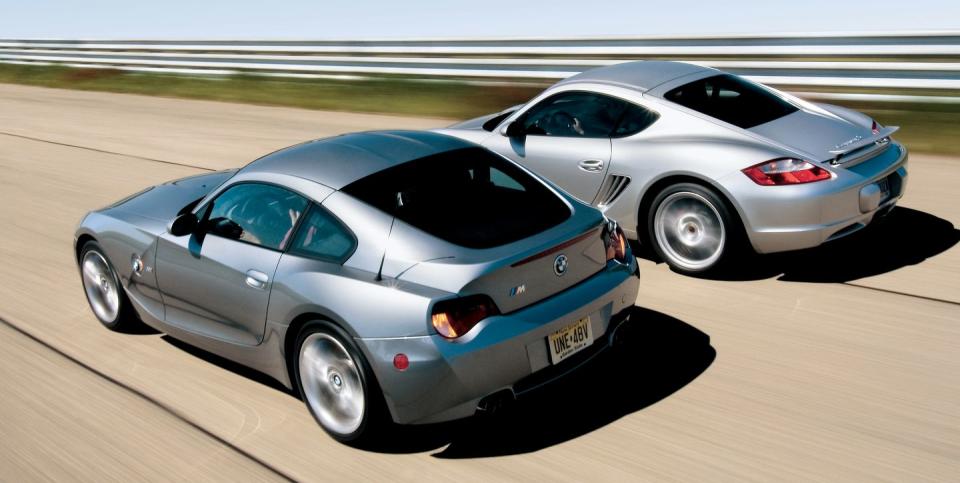
From the August 2006 issue of Car and Driver.
The tradition of sports-car automaking in recent history has been to turn out a roadster, wait until sales slip, then produce a hardtop to pick up the slack. To the non-enthusiast driver, the idea of turning a perfectly good convertible sports car into a hardtop coupe must seem as pointless as the plot of the film Snakes on a Plane. Why give up the joys of driving alfresco to permanently insert yourself into a rolling phone booth, especially if it costs about the same as the ragtop? But adding a roof to a convertible makes sense to car enthusiasts, because the roof increases structural rigidity that in turn allows for a sportier chassis.
In general, a stiff structure leads to a car that is more precise all around, as everything that is intended to move on a car (wheels, suspension, steering) works best when it is attached to a structure that moves about as little as a line at the DMV. Bolt a terrific chassis to a less-than-rigid platform, and movement in the structure will introduce unpredictable motion and inexact wheel control that will muddy handling. Stiff springs, often found on sporting cars, only exacerbate the motion in a flexing structure. Similarly, a floppy structure will introduce imprecision to the steering system, potentially degrading feel and accuracy.
The Porsche Cayman S and the recently introduced BMW Z4 M coupe are hardtop versions of the Porsche Boxster and BMW Z4 M roadster, although Porsche takes exception to that assessment and wants the Cayman considered as a completely separate model line. Delusion aside, the Cayman S and the M coupe are in the grand, olden-day tradition of the MGB GT coupe and Triumph GT6, trading open-air motoring for a distinctive look and the dynamic benefits that come from increased structural rigidity. Indeed, Porsche claims the hard-top Cayman S is 100 percent more rigid than a softtop Boxster S. Both deliver on the promise of the coupe née convertible by offering a driving experience that is different—more sporting and track-ready than that of their cloth-top brethren.
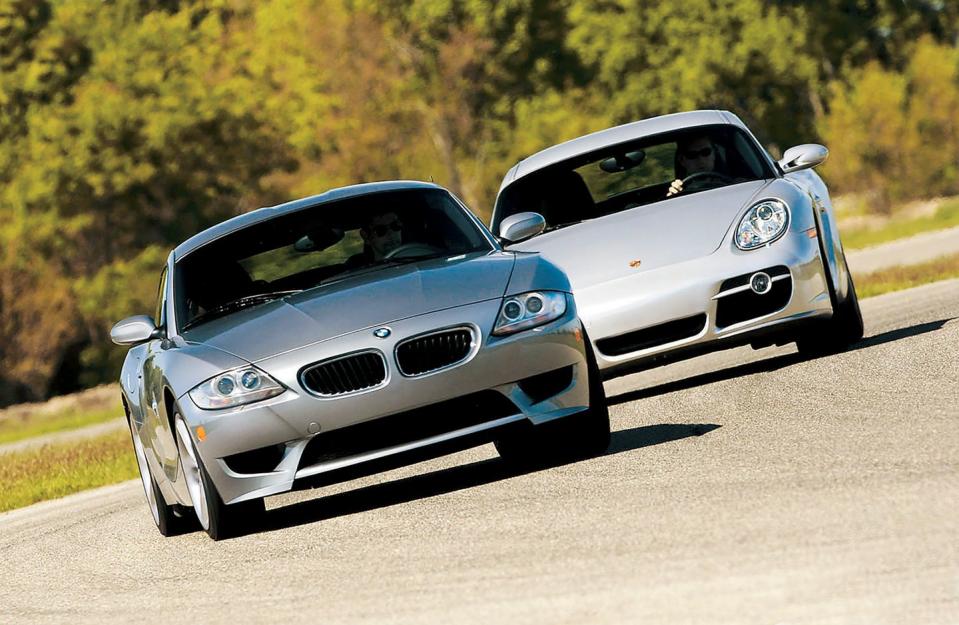
For the hardtop Cayman S, Porsche charges $4200 more than the price of the convertible Boxster S. BMW, though, charges $2000 less for the M coupe than the convertible M roadster. We can imagine that more than a few customers have walked into a Porsche dealership and balked at the idea that the fixed-roof car costs more than the ragtop. Porsche points out a significant fact: The Cayman S has a larger, 3.4-liter engine and 15 more horses than the Boxster S. But pricing the Cayman above the Boxster does separate the driving poseur from the purist.
At this point you’re probably wondering when we’re gonna insert the 400-hp Corvette into this comparison test. No, the Vette remains in the wings because Corvette coupes all have removable targa-style roofs, whereas our two Germans have fixed roofs. If you’re thinking a Z06, which has a fixed roof, would fit in with these coupes, we’d argue that its 505 horsepower puts it in a different league. Arbitrary, you say? Well, you and tech director/Corvette drooler Larry Webster should get a room. In any event, the Corvette isn’t here, so it’s Germany versus Germany, BMW versus Porsche. And after a week of comparing the Cayman S and M coupe, we’ve discovered that although both are spawned from roadsters and offer nearly identical performance, it was easy to choose a winner.
Second Place: BMW Z4 M Coupe

We’ve been waiting to get behind the wheel of the M coupe since BMW pulled the wraps off of it at the Frankfurt auto show in 2005. We still remember with fondness the last-generation M coupe, even though in silhouette it looked like a low-top boot. When BMW stopped producing the original M coupe in 2002, it was 315 horsepower strong and arguably the most amusing car in BMW’s lineup. Would the new coupe, we wondered, be engaging enough to make us forget the fondness we had for its predecessor?
HIGHS: Idiosyncratic styling; willing engine; nearly matches the Porsche’s performance; thick, communicative steering wheel; relatively low price.
LOWS: Limited visibility, harsh ride, lacks the playful chassis and feel of the Cayman S, mysteriously ran out of fuel twice.
The ’06 M coupe is a striking and handsome design when you see it in person. Admittedly, there is a great deal of excited styling, flame surfacing, and what-not crammed into its diminutive 161.9 inches, but all the discordant lines somehow gel together to give off a pleasant vibe that suggests a baby Aston Martin. That might be a stretch, but we can all agree that this M coupe’s exterior design will turn on a larger swath of the populace than the previous M coupe did. When parked next to the Porsche, the Z4 M consistently drew more attention and praise. Perhaps passersby didn’t realize the Cayman S was a new model and mistook it for a 911, a mistake that Cayman owners likely won’t mind.
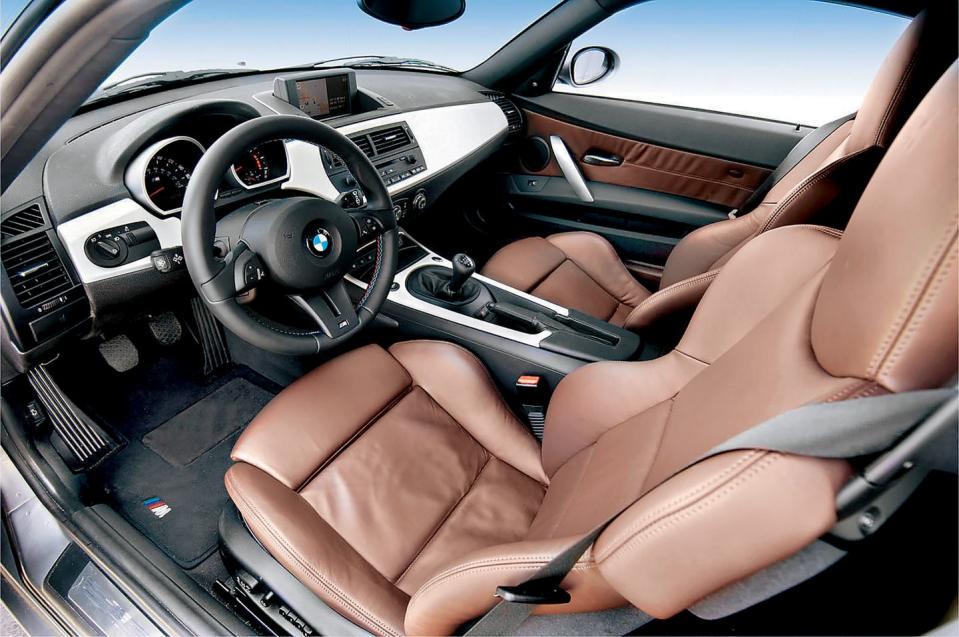
Under the long hood of the M coupe is the familiar iron-block inline six-cylinder engine with an aluminum head that currently propels the M3 and the Z4 M roadster. As in the M roadster, the engine makes 330 horses high up at 7900 rpm, with 262 pound-feet of torque coming at 4900 rpm. The BMW’s logbook on this comparo was full of praise for the responsive flexibility and “angry metallic wail” of the powerful straight-six. It’s connected to the engine by a ZF six-speed manual that boasts short throws but has a slightly rubbery feel. We also found that it’s easy to beat the second-gear synchros during a high-rpm shift from first to second gear. You get a teeth-rattling grrauuch!
A quick run through the 3303-pound M-car’s gears produces a zero-to-60 time of 4.8 seconds, a quarter-mile time of 13.4 seconds at 105 mph, and a governed top speed of 160 mph. The Cayman S rang in at 4.8 seconds to 60 and posted a slightly quicker quarter-mile time of 13.3 seconds at 107 mph on its way to an ungoverned top speed of 166 mph. This M coupe proved to be a couple of ticks slower than the M roadster we tested in June, which was just 26 pounds lighter (that performance difference is likely attributable to production variation and a green engine). Nevertheless, the BMW is quick and has shorter gearing (through the first four gears) than the Cayman S, endowing it with an eagerness that makes it feel faster than the Porsche in day-to-day urban driving.
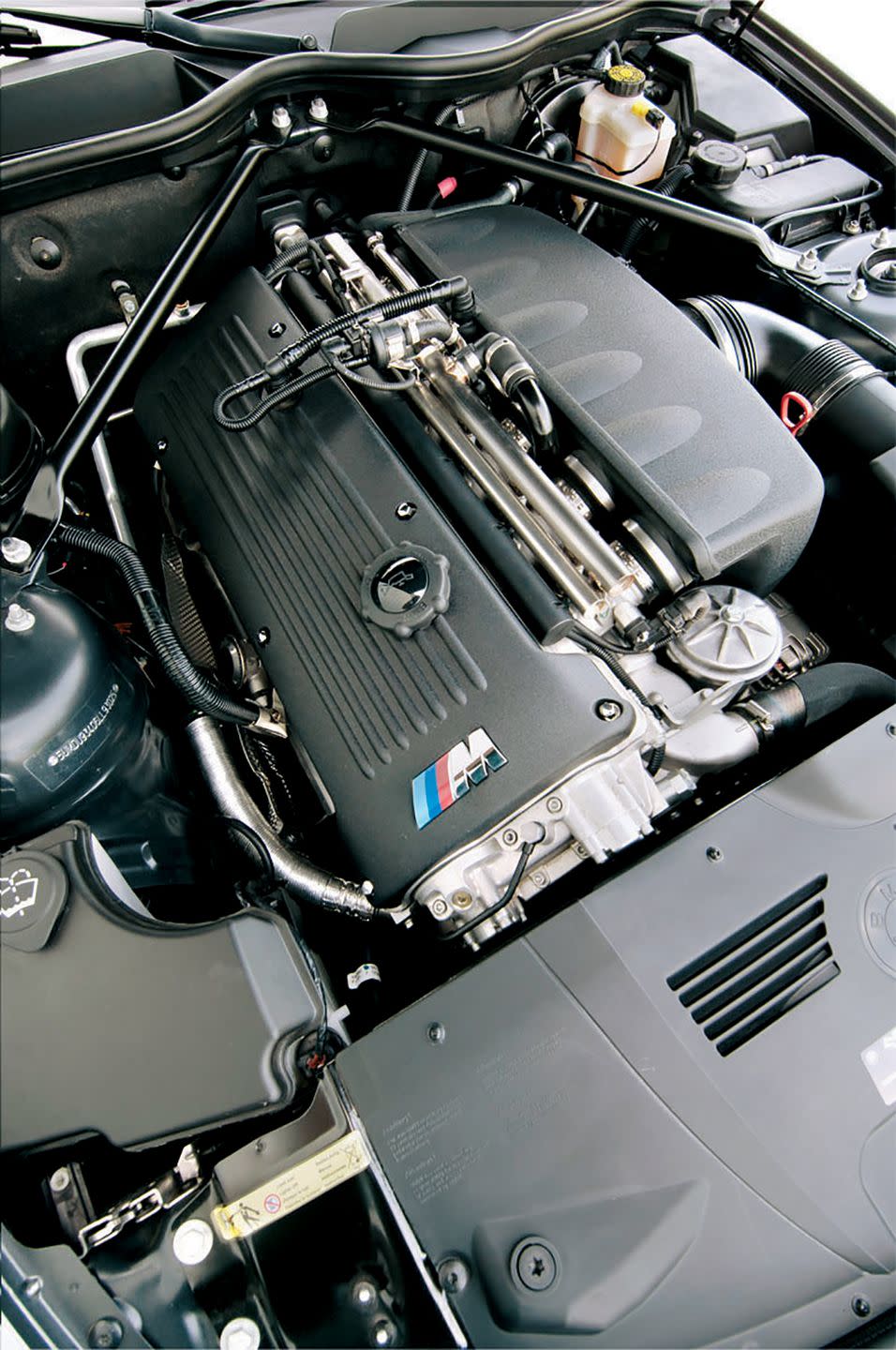
On the highway, the coupe locks onto the horizon and rarely requires any correction to stay steadfastly in a lane, but the addition of a roof means it’s not so easy to see the traffic around you. The view out the back is only good for reading the license plate of the car directly behind, rear-quarter views are blocked by the large C-pillars and hatch, the windshield is so short you’ll have to crane your neck to see stoplights dangling overhead, and the roof creeps into one’s peripheral vision. Not surprisingly, six-foot-five tech editor Dave VanderWerp griped the loudest about the pillbox-view interior. It does feel smaller and more intimate than the one-cubic-foot difference between the two cars suggests. However, for humans of a more reasonable stature, the M coupe’s intimacy lends a special feel that is absent in the more spacious Cayman. Whenever we’re in the Cayman, we’re reminded of its brother, the Boxster. The M coupe somehow manages to make us completely forget the Z4 with which it shares much of its interior.
After a slog of 150 or so miles, we arrived at GingerMan Raceway in South Haven, Michigan. We would have been fresh and ready to start lapping the M coupe, but we needed a moment to walk off the miles owing to the stiff ride, unyielding seats, and a seating position that arranges the driver almost between the rear wheels. Perhaps our glutes were just sore and sensitive from racing go-karts a few days before, but the Cayman S didn’t draw any such complaints. This would also be a good time to mention that the M coupe ran out of gas on the way to the track while continuing to show an eighth of a tank on hand and a range of 40 miles. Unnervingly, it repeated this failure a second time, the needle showing a quarter of a tank and 60 miles still in the bank. A fill-up revealed that the coupe had mysteriously run out of fuel with four gallons in its 14.5-gallon tank.
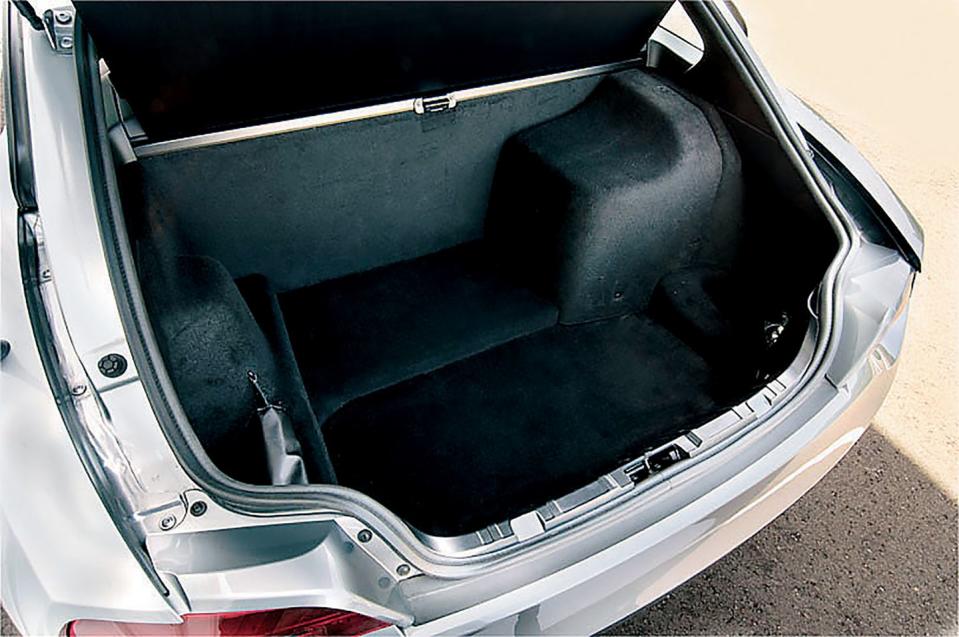
On the track, the M-car’s engine proved willing and eager to pull the coupe hard out of corners. Steering feel through the thick-rimmed, multifunctional steering wheel received praise from associate technical editor Robin Warner. “I love gripping the thick wheel in my hands,” he enthused, “and I always know what the car is doing.” However, what Warner giveth, Warner taketh away: “Unfortunately, what it’s always doing is understeering.”
Supporting the M coupe are struts up front and a multilink setup in back. Compared with the M roadster, the coupe has higher spring rates and more aggressive damping. Many chassis parts are shared with the M3, and although the tuning is different, the setup is conceptually the same. Common components include the rear subframe, limited-slip differential, rear anti-roll-bar mounting points, wheel bearings, front control arms, and vented and cross-drilled rotors clamped by single-piston calipers that are shared with the M3 Competition package. On the skidpad, the coupe clung to the tune of 0.89 g. On the track, it lacks the fluidity, sensitivity to weight transfer, and overall grip of the Cayman. We all agreed that the M coupe is willing and easy to drive on the track, but it takes only one corner in the Cayman S to realize the Porsche has one of the best sports-car chassis this side of a Lotus.
Even before we started lapping GingerMan’s 1.88-mile circuit, the brake feel of the M coupe drew some flack: “Longish pedal travel, strong and grabby, but lacking the firm pedal of the Porsche.” Nonetheless, the BMW equaled the Porsche’s 154-foot stop from 70 mph. After three hot laps, the brake pedal became familiar enough with the carpet that we’re surprised they didn’t get engaged. As the brakes began to fade, the Continental ContiSportContact tires began to lose grip and squirm underneath. Interestingly, BMW was stuck with tires that are a generation old. Continental couldn’t make sufficient quantities of its ContiSportContact 2 series in the necessary sizes in time for the M coupe’s launch. The old Contis have an M3 marking on the sidewall, which indicates that BMW had some say in their development, but they still pale next to the Cayman S’s rubber. Porsche equips most of its cars with Michelin Pilot Sport PS2s, and the extra grip the Cayman S enjoys over the M coupe is probably due to Porsche’s choice of rubber. With more time, we might have out-fitted the M coupe with PS2s to see how the tires affect skidpad grip and lap times.

 Yahoo Autos
Yahoo Autos 